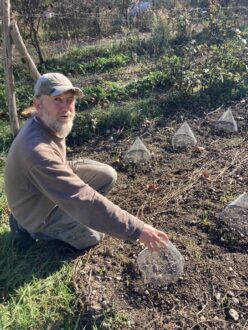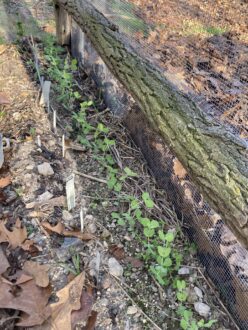KEEZLETOWN, Virginia – On a shelf at Tangly Woods, a 6-acre homesteading farm at the base of the Shenandoah Mountains, sits the 1982 land survey map book for Rockingham County with a description of the farm property’s soil stating, “Not suitable for agriculture.”
But for the past two decades, Jason Myers-Benner and his family have strived to heal the land by managing the naturally compacting soils and combating a history of land misuse through no-tillage, soil health measures, and conservation practices.
“Our goal is to leave the soil in better condition than we found it in,” said Myers-Benner, strolling through his property on a cool November day. He gave a quick run-down of the history of the land: silty, chert (rocky) soil that naturally compacts; prone to erosion; not suitable for tillage, although the area was once farmed in wheat and barley. There’s even a story that a woman who owned the land during the Great Depression sold the top soil for money.

One of the goals at Tangly Woods is to find the right crop mixes that boost soil health while offering a consumable, year-round product. One successful mix has been wheat and peas.
“Growing grains and legumes together reduces fertilizer needs and increases nitrogen, while increasing soil organic matter,” said Myers-Benner. “My goal has been to find an overwintering, dwarf, edible dry pea that can be intercropped with the wheat. The issue is there doesn’t appear to be a winter dwarf variety commercially available. You can get edible peas. You can get a dwarf pea. You can find a winter pea, but you can’t seem to get a dwarf, edible, winter pea.”
This is where the Southern Sustainable Agriculture Research and Education (SSARE) program comes in. Myers-Benner, who has a passion for seed breeding, received funding from a SSARE Producer Grant to breed established winter pea varieties with other pea varieties prized for their edibility, and selecting from the resulting offspring a more usable and versatile winter pea, specifically a dwarf variety that can be more successfully sown with wheat.
“The issue with taller pea varieties is that they grow as tall or taller than the wheat and cause the wheat to bend significantly,” said Myers-Benner. “If a short-vining trait can be brought to predominance without sacrificing productivity of dry pea seeds (and possibly edible pods), produce a non-shattering trait, and support threshability, the possibility would then exist for winter wheat and winter peas to be grown together on any scale, with viable dry crops of each of the two being extractable from the mixed harvest. Soils could benefit greatly from this arrangement, and feed millers could have a regional option for acquisition of non-soy leguminous proteins.”
Several years ago, Myers-Benner grew a small patch of Austrian winter pea immediately adjacent to a small patch of Sugar Snap peas in the hopes that they would cross. The next year’s Sugar Snap planting had a few individuals with purple (instead of white) flowers, and less succulent pods, clear evidence of crossing. The seed from those individuals was planted in the fall to test for winter hardiness.

“Many of them were winter-hardy, and since then we’ve been selecting the most palatable of the resulting population of winter peas, even replacing our old Austrian winter peas in the wheat plantings with the more edible version,” said Myers-Benner. “This year, however, at wheat harvest time, after the pea vines had already been extracted from the standing wheat for separate threshing, a few pea vines were discovered that had escaped earlier notice, as they were half the length of the rest, and had not caused the wheat to bend significantly. These vines appeared to be about as healthy and productive of dry peas as the longer vines, but either through genetic dwarfism, growth restraint through simultaneous flowering/fruiting, or another, unknown mechanism, they grew more moderately.”
In the study, suitable winter pea seeds from those crossings will be intercropped with winter wheat in mounded beds, with the peas populating a center row in each wheat bed, and wheat populating the outer rows. Observations will be made at specified points in the peas’ life cycle as to which display the most suitable growth habits and demonstrate the most favorable traits for palatability, productivity, threshability, seed size, and the timing of harvest.
And ultimately, the hope is that one suitable variety will exhibit dwarfism traits. “We’ll find out in the spring,” said Myers-Benner.
